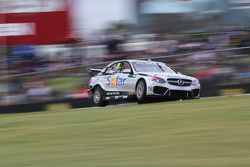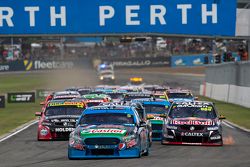Analysis: Why the V8 Supercars SuperSprint format is under fire
It would seem that the SuperSprint format will be given one more chance at Winton this weekend – but time is running out for it to deliver. Andrew van Leeuwen looks at why it may have to be altered.

Photo by: Supercars
















There are two words that almost every V8 Supercars journalist is sick of hearing right now; tyres and format. Those round, black things and the number of laps that they should be used for have dominated press conferences recently, and not in a good way.
To V8 Supercars’ credit, it has responded. There will be an extra set of tyres on offer to drivers for practice this Friday at Winton, and while the SuperSprint format is likely to survive for the weekend, the clock seems to be well and truly ticking on its life span.
The tyre issue
The biggest issue facing V8 Supercars at the moment is the tyre allocation. As we have explained before, a limited tyre bank means teams are forced to use spent rubber during practice. That makes tuning the car difficult, and that first qualifying lap – usually the very first outing for the weekend on new tyres – a journey into the unknown for the drivers.
“You bolt new tyres on, go a second quicker, and then re-learn your whole car again,” explained Mark Winterbottom. “You don’t know where you are.
“That first lap is your lap in qualifying, so it’s hard to switch on and go 20 metres deeper under brakes, and 20 metres earlier on the throttle and all those sorts of things, because it’s guessing.”
The problem even extends outside the garages. Essentially, the practice times mean nothing. They provide next to no insight into who is on the pace and who isn’t; for example, Tim Slade and David Wall led the times on Friday in Perth, but failed to trouble the front-runners for the rest of the weekend.
Slade himself questioned the point of even having a press conference on Fridays.
“The tyres are what they are, but we come up here to the press conference, and we’re supposed to talk about our result for the day, and it doesn’t feel genuine.”
Hopefully, having an extra set at Winton works, and the idea is picked up for the remaining rounds.
The format issue
Assuming that some extra rubber will help solve the problems currently plaguing Friday at a SuperSprint meeting, the next issue to look at is Saturday.
This is essentially the problem day. To be fair, the Sunday part of the SuperSprint works pretty well. A 200-kilometre race, with a set of softs to keep things interesting, seems to be a decent recipe for good racing. Barbagallo Raceway was perfect proof of that.
But the Barbagallo round was also perfect proof that Saturday might need a tweak. Currently, SuperSprint rounds feature two 60-kilometre races on Saturday – down from two 100-kilometre races in 2014.
I get the idea; short and sharp to keep things interesting. But the problem is the races are too short. The hard tyre hangs on too well for that distance, but still doesn’t have the grip to entice drivers into good racing.
And with half the points on offer compared to Sunday, and a really short turnaround between the two races, there just isn’t the incentive to have a go. In fact, in some cases there is more incentive to just throw the race away, as Shane van Gisbergen did in Perth.
The solution
The obvious option is longer races, either a switch back to a pair of 100-kay races or a single 120-kilometre race. The only issue with the second option there is that it, with a pit-stop, it doesn’t address the most crucial of the current issues – tyre life. On the hard tyres, the stints would still be too comfortable.
Maybe a better idea is to stick with 60-kay races, but use the soft tyre. Not only will it make the car racier in the opening stage, but it will definitely start to fade at the end, which could create some grandstand finishes if drivers have been able to make their tyres last better than others without losing too much ground.
Longer term, it may well be worth decreasing the points gap between Saturday’s races and the feature on Sunday.
If you give the drivers something to race for, they’re more likely to go racing.
Be part of Motorsport community
Join the conversationShare Or Save This Story
Subscribe and access Motorsport.com with your ad-blocker.
From Formula 1 to MotoGP we report straight from the paddock because we love our sport, just like you. In order to keep delivering our expert journalism, our website uses advertising. Still, we want to give you the opportunity to enjoy an ad-free and tracker-free website and to continue using your adblocker.















Top Comments